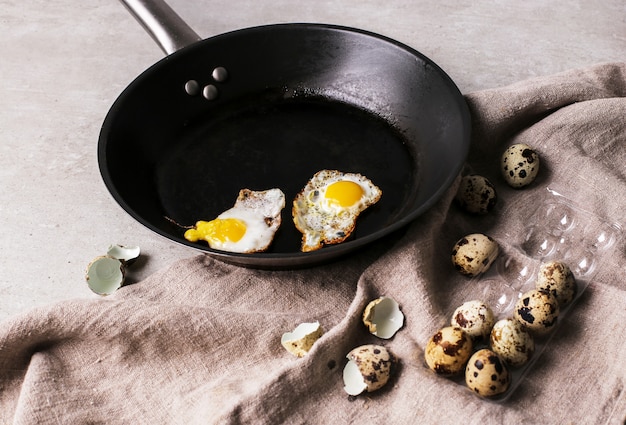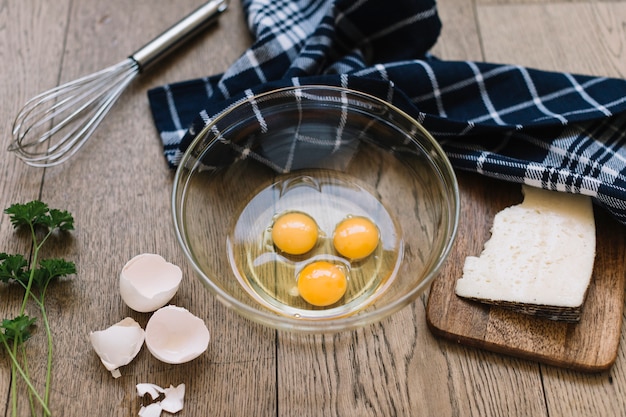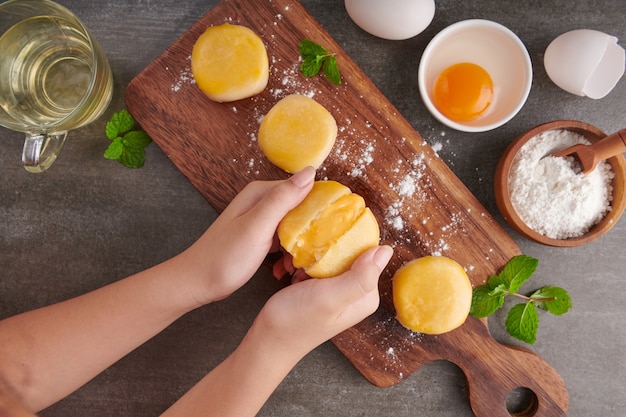Alright, let's talk about fried eggs. Seems simple, right? But trust me, there's a whole world of difference between a decent fried egg and one that's truly perfect. You know, the kind that makes your mouth water just looking at it? That's what we're going for here.
This isn't just a recipe, it's a journey. We'll dive into the nitty-gritty details, from choosing the right eggs to mastering those crispy edges. I'll even share some personal experiences, you know, the good, the bad, and the downright hilarious, because who hasn't had a few fried egg disasters along the way?
So buckle up, egg enthusiasts, because we're about to unlock the secrets to fried egg perfection.
(Part 1) The Egg-cellent Foundation: Choosing Your Eggs

Finding the Right Eggs: Freshness is Key
Let's start with the foundation of any great fried egg – the egg itself. I'm a firm believer in using the freshest eggs you can find. They'll have a vibrant yellow yolk, a richer flavour, and hold their shape better in the pan. If you're lucky enough to snag some free-range or organic eggs, go for it! The difference in taste is truly noticeable.
The Yolky Debate: White vs. Brown
Now, you might be wondering about the age-old question: does the shell colour matter? I've had this debate with friends countless times. Truth is, the colour of the shell doesn't impact the flavour at all. It's all about the breed of the hen. Brown eggs come from hens that lay brown eggs, and white eggs come from hens that lay white eggs. It's that simple!
The Size Matters: Small, Medium, or Large?
The size of your egg matters too, especially when it comes to cooking time. Small eggs cook faster than large ones, and the yolk might be a little runnier. Larger eggs are great for a hearty breakfast, but they'll take a bit longer to cook through.
(Part 2) Mastering the Tools: The Equipment You Need

The Pan: A Non-Stick Partner in Crime
You'll need a good, non-stick pan. I'm talking about a pan that's smooth, even, and doesn't let your precious egg stick to the bottom. I've had my fair share of pan disasters, let me tell you. A good non-stick pan can be your best friend in the kitchen, especially for delicate operations like this.
The Spatula: Your Egg-Flipping Companion
A good spatula is essential for flipping your eggs without breaking the yolk. I prefer a thin, flexible spatula with a rounded edge, which helps to slide under the egg and lift it gently. You want a spatula that's comfortable in your hand and lets you control the egg with ease.
The Heat: Get It Right, Get It Hot
The temperature of your pan is key. Too low, and you'll end up with a greasy mess. Too high, and your eggs will burn before the whites even set. Aim for medium-high heat – you want your pan to be hot enough to sizzle when you add a drop of oil or butter.
(Part 3) Cracking the Code: Preparing Your Eggs

The Crack: A Gentle Touch
When cracking your eggs, be gentle. Tap the egg lightly on the edge of your bowl. You want to create a small crack, not a gaping hole. And for goodness sake, avoid any shell fragments falling into the egg! I've learned the hard way that even a tiny piece of shell can ruin the perfect egg.
The Whites: A Little Separation
Now, this is where things get a little fancy. For perfectly crispy edges, separate your whites and yolks before frying. It may sound like an extra step, but trust me, it's worth it. The whites will spread out quickly and create a beautiful, crisp crust around the yolk.
(Part 4) The fried egg technique: From Beginner to Pro
The Classic Fried Egg: A Simple Approach
This is the most common way to fry an egg. Heat your pan over medium-high heat, add a bit of oil or butter, then crack your egg directly into the pan. Let the whites set, then carefully slide your spatula under the egg to flip it over. Cooking time depends on how you like your yolk, but aim for around 2-3 minutes.
The Sunny-Side Up: A Golden Treat
For a sunny-side up, cook your egg for a shorter time, just until the whites are set and the yolk is still runny. You don't want to flip it. It's a delicate beauty that needs to be handled with care.
The Over-Easy: A Touch of Runniness
This is my personal favourite! Cook your egg until the whites are set, but keep the yolk runny. Then, gently flip it over for a few seconds, just to cook the bottom of the yolk a little. It's a delicate balance between cooked and runny, and I love that contrast.
The Over-Medium: A Happy Medium
For an over-medium, cook your egg longer, letting the yolk set slightly but still retain some runniness. It's a happy medium between a runny yolk and a fully cooked one.
The Over-Hard: Fully Cooked and Ready to Go
If you prefer your yolks cooked all the way through, go for over-hard. Cook your egg until the whites are set and the yolk is no longer runny.
(Part 5) Tips and Tricks: Level Up Your Fried Egg Game
The Water Trick: Avoiding a Sticky Situation
Ever had an egg stick to the pan? Me too. The solution? A little bit of water. After your egg is in the pan, add a splash of water around the edges. The steam will help loosen the egg and prevent it from sticking. It's a little trick I learned from my grandmother, and it works like a charm.
The Salt and Pepper: Seasoning to Perfection
Don't forget to season your eggs with salt and pepper! Salt helps draw moisture from the egg, resulting in a crispier edge. Pepper adds a nice spicy kick, but that's up to your personal preference.
The Butter: A Richer Flavor
Butter adds a rich flavour and colour to your eggs. Just a small amount is enough to coat the pan and give your eggs that golden hue. It's the little things, you know?
(Part 6) Variations on a Theme: Taking Fried Eggs to New Heights
The Fried Egg Sandwich: A Classic comfort food
We've all had it, we all love it. A fried egg, a slice of cheese, some bacon, maybe some avocado - the perfect combination for a quick and satisfying meal. It's a classic for a reason!
The Fried egg salad: A Lighter Option
This is a great way to enjoy a fried egg without the heaviness of a sandwich. Mix your fried egg with some chopped vegetables, a bit of mayonnaise, and you're good to go. It's a lighter, more refreshing option.
The Fried Egg Bowl: A Gourmet Twist
For a more sophisticated take, try a fried egg bowl. This is a great way to use up leftover rice or quinoa. Top it with a fried egg, some veggies, and a drizzle of your favourite sauce. It's a simple, yet elegant meal.
(Part 7) The Perfect Fried Egg: A Personal Journey
You know, the quest for the perfect fried egg is a journey. It's about experimentation, learning from your mistakes, and eventually finding your own perfect technique. It's a journey I've been on for years, and I'm still learning new things.
My Egg-ventures: Learning from Experience
Remember that time I tried to cook an egg in a pan that was too hot and ended up with a burnt mess? Or the time I flipped an egg too early and broke the yolk? Let's just say, there have been some casualties along the way. But with each misstep, I learned something new.
The Joy of Discovery: Finding My Perfect Egg
It's been a journey of trial and error, but I've finally found my perfect fried egg technique. It's a simple one, really: a pan heated to medium-high heat, a little bit of butter, and a perfectly cooked over-easy egg. It's the little things, you know?
(Part 8) Beyond the Plate: The Fried Egg's Place in Culture
The humble fried egg is more than just a breakfast staple. It's a symbol of comfort, a source of inspiration, and a culinary icon.
The Art of the Egg: A Culinary Masterpiece
There's a certain beauty to a perfectly fried egg. The golden yolk, the crisp edges, the way it contrasts with the white of the plate - it's a culinary masterpiece. It's a simple dish, but it can be so visually appealing.
The Egg in Literature and Film: A Timeless Symbol
The fried egg has been featured in countless books and films, from the iconic "Breakfast at Tiffany's" to the classic "The Very Hungry Caterpillar." It's a symbol of simplicity, nourishment, and life itself. It's a truly timeless symbol in our culture.
(Part 9) FAQs: Answering Your Fried Egg Questions
Here are some common questions about fried eggs, answered in detail:
1. What oil is best for frying eggs?
While you can use any oil you like, I prefer a neutral oil with a high smoke point, like canola or vegetable oil. Avoid olive oil, as it has a lower smoke point and can burn easily. You want your oil to be able to heat up without burning before the egg is cooked.
2. How do I prevent my egg whites from spreading too much?
If you're worried about the whites spreading too much, you can try adding a little vinegar to the pan. The acid in the vinegar will help the whites set faster and prevent them from spreading too far.
3. How do I tell if my egg is cooked to my liking?
It comes down to personal preference. If you like your yolk runny, cook it for a shorter time. If you prefer a more cooked yolk, cook it for a bit longer. Experiment to find what you like best.
4. What can I do with leftover fried eggs?
Leftover fried eggs can be used in a variety of dishes. You can add them to salads, sandwiches, or even soups. Get creative and experiment with different flavour combinations.
5. What are some other ways to cook eggs?
There are many ways to cook eggs! You can try scrambled eggs, omelets, poached eggs, or even baked eggs. The possibilities are endless!
(Part 10) Conclusion: The Art of the Perfect Fried Egg
So there you have it: my ultimate guide to perfect fried eggs. It's a journey of discovery, a quest for culinary perfection, and a celebration of one of the most simple yet delicious foods on the planet. Remember: practice makes perfect, and with a little patience and attention to detail, you'll be flipping golden, crispy-edged masterpieces in no time. Happy frying!
Everyone is watching

Prime Rib Roast Cooking Time Chart: Per Pound Guide
Cooking TipsPrime rib roast. Just the name conjures images of lavish dinners, crackling fires, and hearty laughter. It’s ...

How Long to Bake Potatoes in the Oven (Perfect Every Time)
Cooking TipsBaked potatoes are a staple in my kitchen. They're incredibly versatile, delicious, and surprisingly easy to m...

Perfect Rice Every Time: The Ultimate Guide to Cooking Rice
Cooking TipsAs a self-proclaimed foodie, I've always been a bit obsessed with rice. It's the foundation of countless cuisi...

The Ultimate Guide to Cooking Asparagus: Tips, Techniques, and Recipes
Cooking TipsAsparagus. The mere mention of this spring delicacy conjures up images of vibrant green spears, crisp and burs...

Ultimate Guide to Cooking the Perfect Thanksgiving Turkey
Cooking TipsThanksgiving. Just the word conjures up images of overflowing tables laden with delicious food, the scent of r...
